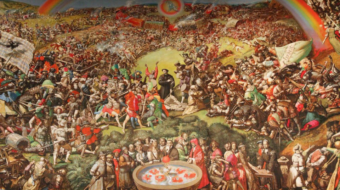
Movie Review
The Tree of Life
Written and directed by Terrence Malick
Starring Brad Pitt, Sean Penn and Jessica Chastain
138 minutes, 2011, PG-13
Four words I never thought I’d see in the same film: Sean Penn and dinosaurs. Yet they co-exist in Terrence Malick’s latest cinematic tour de force, The Tree of Life. The movie’s meaning is as elusive as its writer/director is famously reclusive. At its Cannes Film Festival premiere Tree was both booed and applauded, yet went on to earn the coveted Palme d’Or.
Tree comprises at least three stories. Ostensibly the primary plotline, and the most accessible, is the saga of the O’Briens, a Texas family whose strict businessman patriarch is portrayed by Brad Pitt. Jessica Chastain depicts Mrs. O’Brien as a loving, nurturing mom of three sons. Malick also cast non-actors in significant roles, notably Hunter McCracken, debuting as Young Jack, the eldest O’Brien boy.
Malick deepens the complexity and even mystical nature of Tree by intricately interweaving the conventional O’Brien narrative with the two other storylines. Sean Penn portrays the adult Jack as an alienated architect, estranged in a wilderness of contemporary skyscrapers, brooding on the meaning of life. These sequences feature Fellini- or Antonioni-esque existential ruminations on modern life. Penn’s essentially dialogue-less role recalls the expressiveness of the great silent screen actors.
The third leitmotif is the film’s most obscure yet virtuoso. In visually stunning sequences, the ambitious Malick and his stellar FX team attempt to render nothing less than the Big Bang Theory of the cosmos, the origins of life itself, and the Darwinian process of natural selection. The “tree” of this 138-minute extravaganza is of course the one in the Garden of Eden, with the fruit that bestows life everlasting. Tree is Albert Einstein meets Sergei Eisenstein.
In the intense inter-cutting of these three cinematic strands, Tree asks really big questions: Why are we? What are we doing here? What does it mean? What is the nature of being and consciousness?
Along the way, some viewers are bound to get lost in space, while others more attuned to spirituality and pondering the splendor and wonder of it all will go along for the ride, watching in hushed awe, as if beholding a religious experience. Malick has made visual what the quest for enlightenment looks – and sounds – like.
Since the beginnings of film, cineastes have debated how to make films. Should movies be a strictly storytelling vehicle, unspooling in a logical, linear manner, like a novel or play? Or is there another path to pursue, one less traveled by an expensive medium dominated by commerce? Should films be expressed cinematically, utilizing the uniquely, purely audio-visual language, structure, and attributes of the art form? The American motion picture industry has overwhelmingly embraced the traditional narrative anchored in dialogue.
That’s why the appearance of a Terrence Malick movie is greatly anticipated and treated as a special event by lovers of fine filmmaking: Malick reignites this almost forgotten aesthetic debate.
Although Malick is highly regarded as a movie maestro, Tree is only his fifth feature since his directorial debut almost 40 years ago, 1973’s desperados-on-the-run drama Badlands (Martin Sheen and Sissy Spacek). There was a full 20-year hiatus between the 1978 pro-labor ballad Days of Heaven (Richard Gere and Brooke Adams), and his 1998 return with an adaptation of James Jones’s classic WWII novel, The Thin Red Line, with Penn, Nick Nolte and George Clooney. In 2005, The New World, inspired by the Pocahontas (Q’Orianka Kilcher) and John Smith (Colin Farrell) saga, was full of the emotional verve and cinematic timbre that characterize a Malick production.
Tree is in the tradition of experimental cinema, exemplified by Stan Brakhage and Jonas Mekas; but unlike his predecessors, Malick has managed through Fox Searchlight (a Rupert Murdoch company!) to create a big-budget avant-garde movie with high production values. Malick marries music, sound, and sight in a form that is one with, and organically expresses, content. In a sense, Tree is actually closer to Stanley Kubrick’s classic 2001: A Space Odyssey, which was similarly obsessed with evolution and our role in the cosmos.
Terrence Malick is among moviedom’s singular stylists and poets. Some may be left in the dark by The Tree of Life. But if bewildered at times, I was also bewitched, going with the filmic flow of solar nebulae and, yes, the aforementioned dinosaurs. It’s important for this type of experimental cinema to be created, and that there be a place for it in our over-commercialized culture. After all, one filmmaking size does not fit all.
Photo: http://www.foxsearchlight.com/thetreeoflife/










